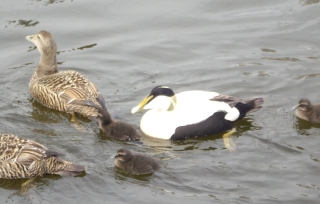....Whitley Bay, Northumberland
To those who hail from these parts this should be an evocative sight; maybe enough to bring a small tear to the eye. The ruined castle on the hill, the blunt cliff and the line of hotels over looking the strip of beach that is the destination for many a Geordie on a hot summer's day.
Sadly this is not one of those days, despite the forecast, and the beach is empty. People around these parts know that when the BBC glibly announce a hot Bank Holiday weekend they are as likely as not talking about somewhere 'doon sooth, man' and on Tyneside it is as much use as a chocolate fireguard. They probably also originated the expression 'too bright too early', which aptly describes a day like we have just had where at 6am the sun blasts down from a cloudless sky, by 10 'o clock it is cloudy and by midday it is raining.
Still, on the bright side, this coast does have a decent stock of lighthouses for us to photograph, proper ones too with the stripes and the red top. It also marks the most southern extent in the North Sea of the range of two of our most colourful birds, the Eider duck and the Puffin, whose striped beak is on loan from the parrot family.
About a mile offshore from Amble lies Coquet Island, a rocky place with a small patch of green scrub and, of course, a lighthouse. The Eider nest only on this island - they presumably have it largely to themselves - and as soon as the chicks emerge from the eggs they undertake the most perilous journey they will ever undertake. Before they are a day old they waddle down to the sea and set out to paddle across the mile or so of open sea that separates the island from Warkworth Harbour. The Herring gulls are out there waiting for just this moment and many chicks clearly never make it but those that do survive are guided by their parents instinctively into Amble marina so they can gain protection from above by hiding beneath the very pontoons we are now moored to. The youngsters in this picture are some of the lucky ones, they will have made the passage within the last day.
Male Eider ducks proudly show their breeding readiness by the pale green colour on the back of their necks, this being enough to attract two or three ladies at a time and as many chicks as they can protect between them. They swim around the marina as if it were put here just for them.



Looks lovely.
ReplyDeleteYou'll just have to start getting up a 6 o'clock then...